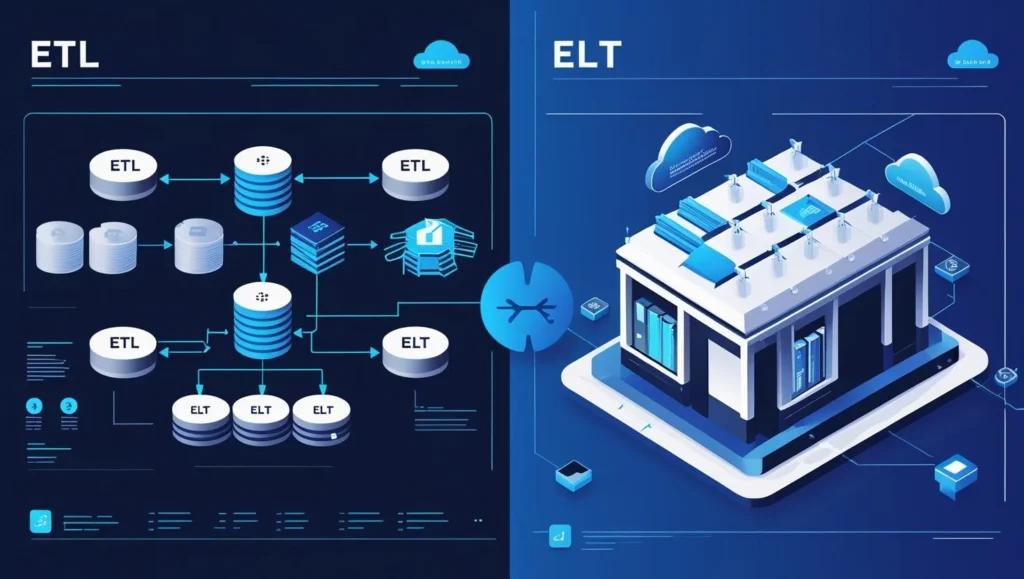Want hands-on training in building ETL and ELT pipelines? 👉 Join our Data Engineering Bootcamp
Introduction
In the world of data engineering, ETL (Extract, Transform, Load) and ELT (Extract, Load, Transform) are two of the most common methods for moving and preparing data. Although the acronyms look similar, the differences in their workflows can have a major impact on speed, scalability, cost, and compliance.
In this complete guide, we’ll explore:
- The key differences between ETL and ELT
- Their pros and cons
- Which to choose based on your use case
- The tools and technologies powering each
By the end, you’ll know exactly when to use ETL, when to use ELT, and how they fit into the modern data engineering landscape.
What is ETL?
ETL stands for Extract, Transform, Load. Data is first extracted from source systems, then transformed into the desired format, and finally loaded into a destination such as a data warehouse.
Advantages of ETL:
- Ensures only clean, structured data reaches the destination
- Ideal for compliance-heavy environments
- Reduces storage costs by storing only transformed data
Disadvantages of ETL:
- Slower for very large datasets
- Less flexible for reprocessing raw data
What is ELT?
ELT stands for Extract, Load, Transform. Data is first extracted from source systems and loaded into the target system in its raw form. Transformations happen inside the target environment (often using the data warehouse’s processing power).
Advantages of ELT:
- Fast loading of large datasets
- Retains raw data for reprocessing and advanced analytics
- Works well with scalable cloud storage and compute
Disadvantages of ELT:
- Requires more storage
- Can be less suitable for sensitive data without masking/encryption
Key Differences – ETL vs ELT
| Feature | ETL | ELT |
|---|---|---|
| Transform Happens | Before Load | After Load |
| Data Stored | Only Transformed Data | Raw + Transformed |
| Flexibility | Lower | Higher |
| Suitable For | On-prem, batch workloads | Cloud-native, big data |
| Tooling | Older generation | Modern cloud stack |
Quick takeaway: ETL is best when data must be processed before storage. ELT excels when storage is cheap and transformations can happen later.
Tools and Stack Recommendations
| Function | ETL Stack | ELT Stack |
| Ingestion | Apache NiFi, Talend | Fivetran, Airbyte |
| Storage | S3, HDFS | Snowflake, BigQuery |
| Transform | Informatica, Spark | dbt, SQL |
| Orchestration | Oozie, AWS Glue | Airflow, Dagster |
When to Choose ETL
- Strict compliance environments (e.g., healthcare, banking)
- Limited storage capacity where only transformed data is kept
- Legacy systems that can’t handle large-scale raw data
When to Choose ELT
- Cloud-native setups with scalable storage and compute
- Big data projects requiring retention of raw datasets
- Advanced analytics or AI/ML workloads needing raw data
Real-World Analogy
Think of ETL as prepping vegetables before putting them in the fridge — you store only what’s ready to use. ELT is like buying groceries in bulk and storing them all — prep happens only when you cook.
Best Practices for Both
- Monitor pipeline performance and optimize bottlenecks
- Use metadata tracking for transparency
- Implement robust error handling and retries
- Automate with orchestration tools
- Integrate security at every stage
FAQs
- Which is faster, ETL or ELT?
ELT is typically faster for loading large datasets, as transformations happen later. - Is ELT more expensive?
Storage costs can be higher, but compute efficiency may offset this in cloud environments. - Can I mix ETL and ELT?
Yes, hybrid models are common. - Which is better for AI/ML?
ELT, because it retains raw datasets. - Do I need different tools for each?
Often yes, though some modern platforms support both. - Which is better for compliance-heavy industries?
ETL, since transformation occurs before storage. - Can ETL work with streaming data?
Yes, but specialized tools like Apache Flink may be needed. - Does ELT require a data warehouse?
Usually yes, to perform in-warehouse transformations. - Which is easier to scale?
ELT, due to cloud-native elasticity. - Can ELT handle real-time processing?
Not always — it’s typically better for batch or micro-batch workloads. - Which saves more storage space?
ETL, because only processed data is stored. - Is ETL outdated?
No, it’s still critical for certain use cases. - Which supports schema-on-read better?
ELT, as raw data is stored. - Can both be automated?
Yes, orchestration tools like Airflow can manage both. - Which should I learn first as a beginner?
ETL, as it helps build foundational data transformation skills.
Both ETL and ELT have vital roles in modern data engineering. Choosing the right one depends on your infrastructure, compliance needs, and growth strategy.
Want to learn how to build both ETL and ELT pipelines from scratch? 👉 Join our Data Engineering Program



